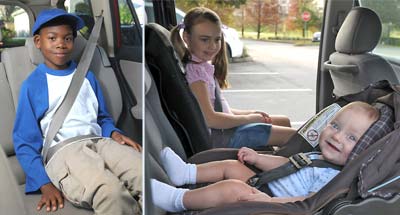
The Reality
Crashes are the leading cause of death for children from 3 to 14 years old. Every day in the United States, an average of 4 children age 14 and younger were killed and 529 were injured in motor vehicle crashes during 2008.
The Good News
An estimated 8,959 lives were saved by child restraints from 1975 to 2008. Car seats have been proven to drastically improve the odds of survival in the event of a crash. Research shows that safety belts and safety seats – when properly used – are the most effective tools in preventing injuries and deaths in vehicle crashes
Common Car Seat Mis-Uses
- the vehicle’s seat belt is not in lock mode (consult your vehicle manual for proper locking directions)
- car seat is not tightly secured to the seat of the vehicle
- child is not tightly secured within the car seat (harness straps too loose)
- child is placed in the forward facing position before the 1 year and 20 pound requirement
- use of both the seat belt and LATCH (lower anchors and tether) restraint system (only one method should be used at a time)
The 4 Stages of Car Seats
Rear-facing seat:
Rear-facing car seats should be used in the back seat as long as possible up to the age and weight limit stated on the seat. (The minimum age and weight for switching to the forward facing position is 1 year and 20 pounds). This position supports the child’s head, neck and back and reduces stress to the neck and spinal cord in a crash. (For optimal protection, the child should ride in a rear-facing seat until he reaches the maximum weight recommended for the safety seat.
Forward-facing seat (older than age 1 and more than 20 pounds):
Use a forward-facing car seat in the back seat until the child reaches the upper height and weight limit stated on the car seat. These seats include an internal harness system that keeps children properly restrained and limits forward motion.
Booster seat (typically age 4 – 8):
Use a belt — positioning booster seat to help ensure proper safety belt placement. Booster seats are available with and without a back. They must be used in the back seat until the child is 4’9″.
Safety belt:
A child is ready to switch to an adult belt when he can sit with his back straight against the vehicle’s seat-back cushion and bend his knees over the seat edge without slouching. The safety belt should fit low across the hips and thighs and across the shoulder and chest. It should not cut into the child’s abdomen or neck.

Recommendations:
- Read the manual: The more you know about your seat, the more likely you are to use it correctly.
- Register your car seat to receive important updates, such as recalls, about your seat. Most manufacturers now offer the option to register online.
- Children under age 13 should ride in the back seat (risk of death in a crash decreases by one-third when this recommendation is followed).
- Talk openly with your friends and family about car seat safety. Encourage them to become knowledgeable about the laws and proper installation techniques.
- When in doubt, have a certified child passenger safety technician check your seat installation. Visit www.seatcheck.org to find a location near you.
Japanese Car Care
![]() ? Auto Repair Miami
? Auto Repair Miami ![]() ?
?
Request Your Appointment Today!
Call: 305-262-0002 ![]() ?
?
![]() ? Info@japcarcare.com
? Info@japcarcare.com ![]() ?
?
![]() ?www.japcarcare.com
?www.japcarcare.com![]() ?
?
Address: 2901 SW 72nd Ave, Miami, FL 33155
Source: AAA.com








